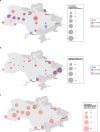Dynamics of hospitalizations and staffing of Ukraine's mental health services during the Russian invasion
- PMID: 37355602
- PMCID: PMC10290323
- DOI: 10.1186/s13033-023-00589-4
Dynamics of hospitalizations and staffing of Ukraine's mental health services during the Russian invasion
Erratum in
-
Correction: Dynamics of hospitalizations and staffing of Ukraine's mental health services during the Russian invasion.Int J Ment Health Syst. 2025 Jan 7;19(1):1. doi: 10.1186/s13033-024-00660-8. Int J Ment Health Syst. 2025. PMID: 39773667 Free PMC article. No abstract available.
Abstract
Background: Since February 2022, the people of Ukraine have experienced devastating losses due to the Russian invasion, increasing the demand for mental healthcare across the nation. Using longitudinal data on mental health facilities across the nation up to summer 2022, we aimed to provide an updated picture of Ukrainian mental health services during the 2022 Russian invasion.
Methods: We conducted a nationwide longitudinal study on Ukrainian inpatient mental health facilities during the Russian invasion since February 2022. We obtained responses from the heads of 30 inpatient mental health facilities, which represent 49.2% of all psychiatric hospitals in Ukraine. Information on hospitalizations and the number, displacement, and injuries of staff in April and July-September 2022 was obtained from each facility.
Results: Facilities across Ukraine reported similar staff shortages in both April and August-September 2022, despite an increase in the number of hospitalizations in July 2022 and a similar percentage of hospitalizations related to war trauma (11.6% in July vs. 10.2% in April, Wilcoxon signed-rank test P = 0.10). Hospitalizations related to war trauma became more dispersed across the nation in July 2022, likely reflecting the return of internally and externally displaced persons to their original locations.
Conclusions: The mental health needs and services changed drastically in the first half-year of the Russian invasion of Ukraine, with those in need more dispersed across the country over time. International aid may need to be scaled up to stably provide mental healthcare, given the displacement of the mental healthcare workforce.
Keywords: Global health; Global mental health; Health policy; Health services research; Humanitarian health; Psychiatry.
© 2023. The Author(s).
Conflict of interest statement
The authors declare no competing interests.
Figures



Similar articles
-
Mental health services in Ukraine during the early phases of the 2022 Russian invasion.Br J Psychiatry. 2023 Feb;222(2):82-87. doi: 10.1192/bjp.2022.170. Br J Psychiatry. 2023. PMID: 36458514 Free PMC article.
-
Study Protocol: Adolescents of Ukraine During the Russian Invasion (AUDRI) Cohort.BMC Public Health. 2023 Jul 12;23(1):1342. doi: 10.1186/s12889-023-16070-3. BMC Public Health. 2023. PMID: 37438711 Free PMC article.
-
A qualitative assessment of war-related rehabilitation needs and gaps in Ukraine.J Health Popul Nutr. 2025 May 29;44(1):175. doi: 10.1186/s41043-025-00912-4. J Health Popul Nutr. 2025. PMID: 40442850 Free PMC article.
-
The battle for mental well-being in Ukraine: mental health crisis and economic aspects of mental health services in wartime.Int J Ment Health Syst. 2023 Sep 25;17(1):28. doi: 10.1186/s13033-023-00598-3. Int J Ment Health Syst. 2023. PMID: 37749608 Free PMC article. Review.
-
The environmental health impacts of Russia's war on Ukraine.J Occup Med Toxicol. 2024 Jan 5;19(1):1. doi: 10.1186/s12995-023-00398-y. J Occup Med Toxicol. 2024. PMID: 38183124 Free PMC article. Review.
Cited by
-
Mental health services during the war in Ukraine: 2-years follow up study.Int J Ment Health Syst. 2025 Mar 28;19(1):11. doi: 10.1186/s13033-025-00667-9. Int J Ment Health Syst. 2025. PMID: 40148922 Free PMC article.
-
Preventing common mental health problems in war-affected populations: the role of digital interventions.Front Digit Health. 2025 Apr 10;7:1586030. doi: 10.3389/fdgth.2025.1586030. eCollection 2025. Front Digit Health. 2025. PMID: 40276570 Free PMC article. No abstract available.
References
-
- Organization WH. Ukraine crisis. Public health situation analysis: refugee-hosting countries, 17 March 2022. World Health Organization. Regional Office for Europe; 2022.
-
- Shoib S, Baiou A, Saleem SM, Chandradasa M, Gaffaz R. Mental health services in conflict areas–An experience from Libya. Asian J Psychiatry. 2022;73:103106. - PubMed
LinkOut - more resources
Full Text Sources
Miscellaneous

